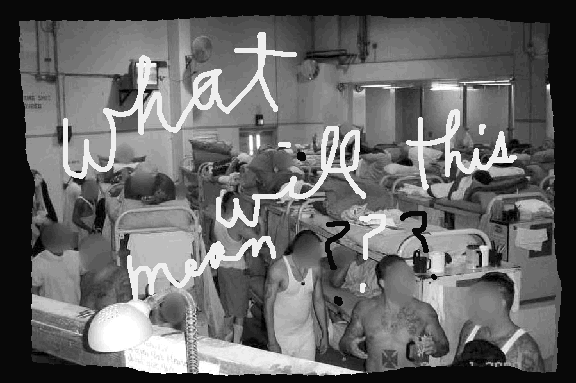A week after the US Supreme Court ruling of Brown v. Plata in which SCOTUS affirmed that the 3 judge panel did, in fact, have the legal right to tell our state that it had to reduce its prison population to sane and manageable levels (AKA by about 33,000 inmates over 2 years), there is starting to be some calm, smart, fact based writing on the topic. (As opposed to the screaming, alarmist, fact-free headlines of last Monday.)
One story of note is the Op Ed in the Los Angeles Times, jointly written by former CDCR head (and former San Quentin warden), Jeanne Woodford, and the Barry Krisberg is research and policy director of the Warren Institute on Law and Social Policy at the UC Berkeley School of Law—both very intelligent people with a combined breadth of experience on the topic that would be hard to equal.
Here are a couple of clips from their essay:
In his dissent from the majority in the recent Supreme Court decision requiring California to reduce its prison population by 33,000 inmates, Justice Antonin Scalia warned that “terrible things are sure to happen as a consequence of this outrageous order.”
But Californians shouldn’t panic. The state won’t have to throw open the prison doors to meet the court’s order if it embraces very modest sentencing reforms.
[SNIP]It is worth noting that a number of states, including Texas, Florida, Illinois, New York, Michigan, Ohio and Washington, have reduced their prison populations over the last 25 years, and independent research has found that not one of these states experienced an increase in crime or recidivism following the reductions. In fact, if drug treatment and other reentry services were provided, the rate of repeat offenses often went down.
California has had its own success story in reducing incarceration numbers without ill effect. Faced with serious overcrowding in state prisons for youth, California reduced its youth prison population from more than 10,000 in 1996 to about 1,000 today. This was the largest decline in juvenile incarceration in American history. Yet during this period, serious youth crime dropped throughout the state, and felony arrests for juveniles and young adults also decreased dramatically.
Read the whole thing and then tell everyone around you to chill. on this topic.
COULD IT BE THAT JUSTICE KENNEDY VOTED FOR THE PLATA DECISION…BECAUSE HE UNDERSTANDS PRISON POLICY?
At least that’s what Dan Morain of the Sacramento Bee has pointed out in an interesting column that talks about Kennedy’s relationship with Clark Kelso and how it may have affected his thinking on the California prison population decision. Here are some clips:
J. Clark Kelso wasn’t the least bit surprised by Supreme Court Justice Anthony Kennedy’s opinion directing that California cut prison population by roughly 30,000 inmates.
Kelso is the court-appointed receiver who oversees health care in the state prison system, documents its many failures, and pushes for improvements.
More than that, Kelso has a personal bond with Kennedy. He was Kennedy’s law clerk in 1983 and 1984 when Kennedy was on the 9th U.S. Circuit Court of Appeals.
[SNIP]Yes, Kennedy usually sides with prosecutors.
But there are nuances, as evidenced by Kennedy’s majority opinion in Brown v. Plata, the landmark prison overcrowding case decided by a 5-4 margin last week.
“He has a fundamental respect and believes the Constitution has fundamental respect for the individual,” Kelso said. “It was not about criminal law. It was about human dignity.”
[SNIP]
Justice Antonin Scalia got worked up in his dissent to the majority decision affirming a lower court order that California reduce its prison population.
He writes that about 46,000 inmates would be “generously rewarded” by a release order. Of those freed, he write, “many will undoubtedly be fine physical specimens who have developed intimidating muscles pumping iron in the prison gym.” Nice turns of phrases, though they’re not grounded in fact…..
COULD A REVISION OF THE OLD BAIL SYSTEM LOWER CALIFORNIA’S INCARCERATION NUMBERS—AND COSTS?
And then on Monday, the New York Times had a provocative Op Ed by Shima Baradaran, an associate professor of law at Brigham Young University and the chairwoman of the American Bar Association Pretrial Release Task Force, that explores the idea of reform of the bail system, as a much needed way to reduce incarceration rates in first in California’s jail and, upstream of them, its overcrowded prisons.
Here’s a clip:
Every year America spends close to $66 billion to keep people behind bars. But almost 500,000 of the 2.3 million prisoners aren’t convicts; rather, they are accused individuals awaiting trial.
While some defendants are able to pay their bail and go free, most cannot, because many judges, lacking firm insight into what types of prisoners are too dangerous to release, set high bail amounts knowing the accused can’t afford them. Though some of these defendants will eventually be found not guilty and go free, keeping them incarcerated before their trials creates a burden on the prison system.
What’s more, detention begets more detention. Defendants detained before trial are more likely to be convicted if they go to trial, more likely to receive prison sentences rather than probation when sentenced, and, given their weak bargaining power with prosecutors while locked up, are more likely to have longer sentences.
A few jurisdictions, however, have begun to think outside the prison cell. In line with recommendations endorsed by the American Bar Association, Miami-Dade County cut costs associated with detention by supervising defendants outside jail at a total cost of around $400 per defendant per year, compared with $20,000 for incarcerated defendants. In Iowa, alternatives to pretrial detention saved the state’s Southern District $1.7 million in 2009.
These and other jurisdictions have also cut costs using technology, like G.P.S. trackers and ankle bracelets, that allow defendants to remain at home — with supervision — while awaiting trial.

